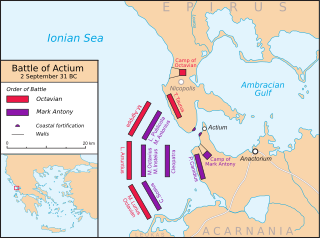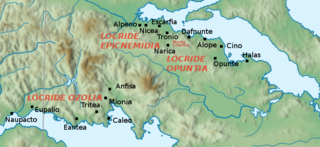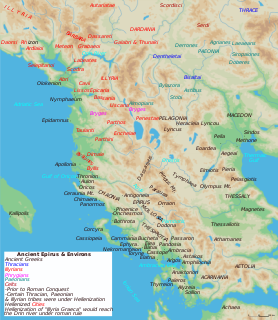 W
WActium or Aktion was a town on a promontory in ancient Acarnania at the entrance of the Ambraciot Gulf off which Octavian gained his celebrated victory, the Battle of Actium, over Antony and Cleopatra, on September 2, 31 BCE.
 W
WAlope was a town of Opuntian Locris on the coast between Daphnus and Cynus. Its ruins have been discovered by William Gell on an isolated hill near the shore in the modern village of Melidoni, Phthiotis.
 W
WAlyzeia or Alyzia (Ἀλυζια), was a town on the west coast of ancient Acarnania. According to Strabo it was distant 15 stadia from the sea, on which it possessed a harbour and a sanctuary, both dedicated to Heracles. In this sanctuary were some works of art by Lysippus, representing the Labours of Heracles, which a Roman general caused to be removed to Rome on account of the deserted state of the place. The remains of Alyzia are still visible in the valley of Kandili. The distance of the bay of Kandili from the ruins to Leucas corresponds with the 120 stadia which Cicero assigns for the distance between Alyzia and Leucas. Alyzia is said to have derived its name from Alyzeus, a son of Icarius. It is first mentioned by Thucydides; in 375 BCE, a naval battle was fought in the neighbourhood of Alyzia between the Athenians under Timotheus and the Lacedaemonians under Nicolochus. The Athenians, says Xenophon, erected their trophy at Alyzia, and the Lacedaemonians in the nearest islands. We learn from the Periplus of Pseudo-Scylax that the island immediately opposite Alyzia was called Carnus, the modern Kalamos.
 W
WAnactorium or Anaktorion was a town in ancient Acarnania, situated on the promontory on the Ambraciot Gulf. On entering the Ambraciot Gulf from the Ionian Sea it was the first town in Acarnania after Actium, from which it was distant 40 stadia, and which was in the territory of Anactorium. This town was for some time one of the most important places in this part of Greece. It was colonized jointly by the Corinthians and Corcyraeans; but in the war between these peoples, in 432 BCE, the Corinthians obtained sole possession of the place by fraud. It remained in the hands of the Corinthians till 425 BCE, when it was taken by the Acarnanians with the assistance of the Athenians, and the Corinthian settlers were expelled. Augustus removed its inhabitants to the town of Nicopolis, which he founded on the opposite coast of Epirus, and Strabo describes it as an emporium of the latter city.
 W
WArtichia was an ancient Greek city located in the region of Epirus. The site is probably located somewhere in ancient Parauaea, now in the Përmet basin.
 W
WBaiake was an ancient Greek city located in the region of Epirus. It was located between Apollonia and Oricos.
 W
WBatiae or Batiai, also known as Bitia (Βιτία), was an ancient Greek city located in the region of Epirus. It was located in Thesprotia, mentioned along with Elateia, and situated in the interior in the neighbourhood of Pandosia. The city-site is located near modern Kastri, Thesprotiko, Lelovo.
 W
WBerenice or Berenike was a Greek city in the region of ancient Epirus, near current Preveza. It was founded by Pyrrhus II of Epirus.
 W
WCharadra, also Charadrus or Charadros (Χάραδρος), was a town of ancient Epirus, situated on the road from Ambracus to the strait of Actium. It is also mentioned in a fragment of Ennius: "Mytilenae est pecten Charadrumque apud Ambraciai."
 W
WCheimerium or Cheimerion was a fortified settlement and harbour of ancient Thesprotia in ancient Epirus, on an eponymous promontory. It lay between the rivers Acheron and Thyamis, and opposite the southern point of Corcyra. In the two naval engagements between the Corcyraeans and Corinthians just before the Peloponnesian War, Cheimerium was the station of the Corinthian fleet.
 W
WChyton, according to Ephorus, was a new city founded in Epirus during the 4th century BC. The city was established by Ionians from Klazomenai.
 W
WCnemis or Knemis was either a range of mountains between the Cephissus Valley and the Gulf of Euboea combined with the Malian Gulf, or was a single mountain located in the northwest of that range. The valley formed the heartland of Phocis, where the river originated, before entering Boeotia north of Orchomenos. The uncertainty of what terrain was meant by "Cnemis" derives from the varying accounts of the many sources.
 W
WCoronta, a small town in the interior of Acarnania, probably lying between Metropolis and Old Oenia. It is cited by Thucydides in the context of the Peloponnesian War where it is said that, after the Battle of Naupactus in 429 BCE, the Athenians made an expedition through Acarnania in which they restored the leader of Corontas, and expelled from the city some inhabitants who were contrary to their interests.
 W
WCranii or Kranioi or Krane was a Greek city on the island of Cephallenia, situated at the head of a bay on the western coast. Thucydides writes extensively about Cranii in his History of the Peloponnesian War. In 431 BCE, it joined the Athenian alliance, together with the other Cephallenian towns; in consequence of which the Corinthians made a descent upon the territory of Cranii, but were repulsed with loss. In 421 BCE the Athenians settled at Cranii helot deserters of Sparta and the Messenians who were withdrawn from Pylos on the surrender of that fortress to the Lacedaemonians. As part of the negotiations with Sparta after the "50 Years Truce" was signed, these people were moved from their garrison at Pylos where they were involved in a blockade of the troops on the island in the bay of Pylos. They were relieved by Athenian troops who then garrisoned the bay. Cranii surrendered to the Romans without resistance in 189 BCE. It is mentioned both by Strabo and Pliny the Elder.
 W
WCreonion or Kreonion was an ancient Greek city in the territory of Chaonia located in the region of Epirus. The city, according to Polybius, belonged to the Dexari.
 W
WEchinus or Echinos was an ancient Greek town of Acarnania. Legend has it that it was founded by a Greek mythological figure named Echinus. It is mentioned by the poet Rhianus, and appears in the list of cities of Acarnania transmitted by Pliny the Elder, who places it between Heraclea and Actium. The site of Echinus is near the modern town of Vonitsa, probably the kastro of Profitis Elias.
 W
WElaea or Elaia, also Elea (Ἐλέα), was a town of Thesprotia in ancient Epirus toward the mouth of the Acheron river. The town is mentioned by Ptolemy. Thucydides calls the surrounding district Elaeatis (Ἐλαιατις) and indicates that Ephyra was in the territory of Elaea. Its port was Elaias Limen, literally the "Bay of Elaea", which the Periplus of Pseudo-Scylax asserts was the main port of Thesprotia.
 W
WElaias Limen, also Elaea or Elaia (Ἐλαία), was a harbour town of Thesprotia in ancient Epirus at the mouth of the Acheron river. The town is mentioned by both Scylax and Ptolemy. The Periplus of Pseudo-Scylax asserts that this was the main port of Thesprotia. The town's site is identified as near Cheimerion.
 W
WElateia or Elatia, also Elatreia or Elatria (Ἐλατρία), was a town of the Cassopaei in Thesprotia, in ancient Epirus, mentioned by Strabo, along with Batiae and Pandosia. It is said to have been a colony of Elis.
 W
WEuripus or Euripos was a town in ancient Acarnania. It is known mainly through epigraphic evidence, including the appointment of theorodokos of the place is mentioned towards the year 356/5 BCE to host theoroi of Epidaurus and also in another entry dated in the period 331/0-313 BCE to receive the theoroi of Nemea. It was a member of the Acarnanian League in the 3rd century BCE. It is also mentioned in the Periplus of Pseudo-Scylax.
 W
WEurymenae or Eurymenai was an ancient Greek city of Molossis located in the region of Epirus. The city belonged to the Molossian koinon and was inhabited by the Arktanoi tribe.
 W
WHecatompedum or Hekatompedon was an ancient Greek city in the interior of Chaonia located in the region of Epirus. Its site is tentatively located near modern Saraqinisht.
 W
WHelicranon or Helikranon was an ancient Greek city located in the region of Epirus. The site of the city is tentatively located near modern Chrysorrachi.
 W
WHeraclea, Heracleia, or Herakleia was an ancient Greek city located in the region of Acarnania. It was founded by Phillip II of Macedon, father of Alexander the Great, in the 4th century BCE. It appears in the list of cities of Acarnania transmitted by Pliny the Elder, who places it near the city of Echinus. Stephanus of Byzantium also mentions the town in his Ethnica. Heraclea is tentatively located near modern Thesis Lekka.
 W
WHyporeiae or Hyporeiai was an ancient Greek town located in the region of Acarnania. Its exact location is unknown, although it has been suggested that it should be located in the east of Acarnania, in the border area with Aetolia.
 W
WIlium or Ilion, also known as Troja (Τροΐα), was a city of ancient Epirus. It is mentioned in the Aeneid of Virgil as a foundation of Helenus after the Trojan War in the land of the Chaonia.
 W
WIthaca, Ithake, or Ithaka was a Greek city on ancient Ithaca.
 W
WOlympe was an ancient Greek city located in the region of Epirus. Its location is probably at modern Mavrovë.
 W
WOropos was an ancient Greek walled settlement located in the region of Epirus. The settlement site is in modern-day Voulista Panaghia.
 W
WPale was an ancient Greek city in ancient Cephalonia. In 435 BCE Pale supported Corinth against Corcyra by sending four ships. Its territory was called Paleis (Παλείς).
 W
WPanormus or Panormos was an ancient Greek harbor settlement mentioned by the geographer Ptolemy, in Chaonia in ancient Epirus, situated nearly midway between Oricum and Onchesmus. Strabo describes it as a great harbour in the midst of the Ceraunian Mountains.
 W
WPassaron was an ancient greek city of ancient Epirus. It was founded by the Molossian king Tharrhypas sometime between 420 and 400 BCE as the capital of the Molossian kingdom. As capital, the Molossian kings and the assembled people were accustomed to take mutual oaths, the one to govern according to the laws, the other to defend the kingdom. Later, in 330 BCE, it became the capital of the newfound united kingdom of Epirus until 295 BCE, when Pyrrhus of Epirus moved the capital to Amvrakia. The town was taken by the Roman praetor Lucius Anicius Gallus in 167 BCE.
 W
WPhanote or Phanota, or Phanoteia (Φανωτεία), was a strongly fortified ancient Greek town of Chaonia located in the region of Epirus. The town's location was of military/strategic importance as it stood in the midst of a valley surrounded by an amphitheatre of mountains, through which there are only two narrow passes. It lies about halfway between the sea and the Antigonean passes, and was therefore of importance to the Romans when they were advancing from Illyria in 169 BCE. Its site is tentatively located near the modern Raveni.
 W
WPhara was an ancient Greek city located in the region of Acarnania.
 W
WPhytia, or Phoeteiae or Phoiteiai (Φοιτεῖαι), or Phoetiae or Phoitiai (Φοιτίαι), was a town in the interior of ancient Acarnania, situated on a height west of Stratus, and strongly fortified. It lay on the road from Stratus to Medeon and Limnaea. After the time of Alexander the Great it fell into the hands of the Aetolians, together with the other towns in the west of Acarnania. It was taken by Philip V of Macedon in his expedition against Aetolia in 219 BCE; but the Aetolians, doubtless, obtained possession of it again, either before or after the conquest of Philip by the Romans. It is mentioned as one of the towns of Acarnania in a Greek inscription found at the site of Actium, the date of which is probably prior to the time of Augustus. In this inscription the ethnic form Φοιτιάν occurs.
 W
WPoionos was an ancient Greek city located in the region of Epirus.
 W
WPronnoi, also known as Pronesus or Pronesos (Πρωνῆσος), was one of the four towns of Cephallenia, situated upon the southeastern coast. Together with the other towns of Cephallenia it joined the Athenian alliance in 431 BCE. It is described by Polybius as a small fortress; but it was so difficult to besiege that Philip V of Macedon did not venture to attack it, but sailed against Pale. Livy, in his account of the surrender of Cephallenia to the Romans in 189 BCE, speaks of the Nesiotae, Cranii, Palenses, and Samaei. Now as we know that Proni was one of the four towns of Cephallenia, it is probable that Nesiotae is a false reading for Pronesiotae, which would be the ethnic form of Pronesus, the name of the town in Strabo. Pronnoi or Pronesus was one of the three towns which continued to exist in the island after the destruction of Same.
 W
WSame was a Greek city in ancient Cephalonia.
 W
WThesprotia was an ancient Greek city located in the region of Epirus.
 W
WThyrium or Thyrion, or Thyreum or Thyreon (Θύρεον), or Thurium or Thourion (Θούριον), or Thyrreium or Thyrreion (Θύρρειον), was a city in ancient Acarnania. Cicero tells us that in sailing from Alyzia to Leucas, he touched at Thyrium, where he remained two hours; and from this statement, as well as from the history of the events in which Thyrium is mentioned, we may infer that it was situated on or near the Ionian Sea, and that it was the first town on the coast south of the channel which separated Leucas from the mainland.
 W
WTorybeia was a city in ancient Acarnania. It is known mainly through epigraphic evidence. Mention is made of the appointment of theorodokos of Torybeia, about the year 356/5 BCE to receive the theoroi of Epidaurus and also an inscription dated to around 330 BCE to accommodate those of Argos. It was one of the cities belonging to the Acarnanian League around 272 BCE.
 W
WToryne, also known as Torone (Τορώνη), was a city of ancient Thesprotia in ancient Epirus. The fleet of Augustus was moored off Toryne a short time before the Battle of Actium, and seems from the order of the names in Ptolemy to have stood in one of the bays between the mouth of the river Thyamis and Sybota. It was located on the Ionian Sea coast, and its site is tentatively placed near present Parga.
 W
WTrampya was an ancient Greek city in the region of Epirus. Its site is unlocated, but near that of Bouneima.
 W
WZmaratha was an ancient Greek city located in the region of Epirus.